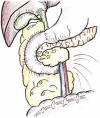Lipomatous Pseudohypertrophy of the Pancreas Taking the Form of Huge Massive Lesion of the Pancreatic Head
- PMID: 21103205
- PMCID: PMC2988859
- DOI: 10.1159/000321989
Lipomatous Pseudohypertrophy of the Pancreas Taking the Form of Huge Massive Lesion of the Pancreatic Head
Abstract
A 70-year-old woman presented with hypogastric pain. Computed tomography and magnetic resonance imaging revealed a retroperitoneal tumor 18.0 cm in diameter with fatty tissue density, ventrally compressing the pancreatic head. We suspected a well-differentiated liposarcoma compressing the pancreas. At laparotomy, the tumor mass was the size of an infant's head; its center was located in the area corresponding to the pancreatic uncus. It was continuous with the pancreatic parenchyma through a poorly demarcated border, and we resected as much of the tumor mass as possible while conserving the pancreatic capsule. Histopathological examination indicated lipomatous pseudohypertrophy of the pancreas with proliferation of mature fatty tissue as the main constituent. At the periphery, islands of acinar tissue were retained among the fatty infiltration, which also contained branches of the pancreatic duct and islets of Langerhans. Previous reports have stated that this disorder only causes fatty replacements throughout the pancreas or in the pancreatic body and tail; however, in this patient, imaging and macroscopic examination revealed no fatty replacements in the pancreatic body and tail. We report this case, which we consider extremely rare, along with a brief review of the literature.
Figures




References
-
- Hantelmann W. Fettsucht und Atrophie der Bauchspeicheldrüse bei Jugendlichen. Virchows Arch. 1931;282:630–642.
-
- Hoyer A. Lipomatous pseudohypertrophy of the pancreas with complete absence of exocrine tissue. J Pathol Bacteriol. 1949;61:93–100.
-
- Nakamura M, Katada N, Sakakibara A, et al. Huge lipomatous pseudohypertrophy of the pancreas. Am J Gastroenterol. 1979;72:171–174. - PubMed
Publication types
LinkOut - more resources
Full Text Sources

